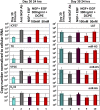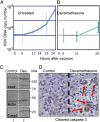Induction of apoptosis accelerates reactivation of latent HSV-1 in ganglionic organ cultures and replication in cell cultures
- PMID: 22908263
- PMCID: PMC3437834
- DOI: 10.1073/pnas.1212661109
Induction of apoptosis accelerates reactivation of latent HSV-1 in ganglionic organ cultures and replication in cell cultures
Abstract
Herpes simplex viruses replicate at the portal of entry into the body and are transported retrograde to sensory neurons in which they can establish a silent, latent infection characterized by the expression of a noncoding latency-associated transcript and a set of microRNAs. At the portal of entry into the body and in cell culture a viral protein, VP16, recruits cellular proteins that initiate a sequential derepression of several kinetic classes of viral genes. Earlier studies have shown that upon reactivation of latent virus in ganglionic organ cultures all genes are derepressed at once, thus obviating the need for VP16 to initiate sequential derepression of viral genes. One hypothesis that could explain the data is that the massive reactivation of all classes of viral genes is the consequence of activation of an apoptotic pathway. Here we show that two proapoptotic drugs, dexamethasone and 2[[3-(2,3-dichlorophenoxy)propyl]amino]-ethanol, each accelerates viral gene expression in ganglionic organ cultures. We also show that in cultured cells apoptosis induced by dexamethasone accelerates viral gene expression and accumulation of infectious virus. The results are surprising in light of the relatively large number of viral proteins that independently block apoptosis induced by viral gene products or exogenous agents. The results suggest that the virus may rely on apoptosis to exit from latency but that apoptosis may be detrimental for virus replication or spread at the portal of entry into the body.
Conflict of interest statement
The authors declare no conflict of interest.
Figures






Similar articles
-
HSV carrying WT REST establishes latency but reactivates only if the synthesis of REST is suppressed.Proc Natl Acad Sci U S A. 2013 Feb 5;110(6):E498-506. doi: 10.1073/pnas.1222497110. Epub 2013 Jan 22. Proc Natl Acad Sci U S A. 2013. PMID: 23341636 Free PMC article.
-
Herpes Simplex Virus 1 Reactivates from Autonomic Ciliary Ganglia Independently from Sensory Trigeminal Ganglia To Cause Recurrent Ocular Disease.J Virol. 2015 Aug;89(16):8383-91. doi: 10.1128/JVI.00468-15. J Virol. 2015. PMID: 26041294 Free PMC article.
-
A gene capable of blocking apoptosis can substitute for the herpes simplex virus type 1 latency-associated transcript gene and restore wild-type reactivation levels.J Virol. 2002 Feb;76(3):1224-35. doi: 10.1128/jvi.76.3.1224-1235.2002. J Virol. 2002. PMID: 11773398 Free PMC article.
-
Regulation of the latency-reactivation cycle by products encoded by the bovine herpesvirus 1 (BHV-1) latency-related gene.J Neurovirol. 2011 Dec;17(6):535-45. doi: 10.1007/s13365-011-0060-3. Epub 2011 Dec 3. J Neurovirol. 2011. PMID: 22139602 Review.
-
Molecular circuitry regulating herpes simplex virus type 1 latency in neurons.J Neurovirol. 2000 Feb;6(1):6-24. doi: 10.3109/13550280009006378. J Neurovirol. 2000. PMID: 10786993 Review.
Cited by
-
Activation of human herpesvirus replication by apoptosis.J Virol. 2013 Oct;87(19):10641-50. doi: 10.1128/JVI.01178-13. Epub 2013 Jul 24. J Virol. 2013. PMID: 23885073 Free PMC article.
-
A virulent bioluminescent and fluorescent dual-reporter Marek's disease virus unveils an alternative spreading pathway in addition to cell-to-cell contact.J Virol. 2014 Oct;88(19):11617-23. doi: 10.1128/JVI.01482-14. Epub 2014 Jul 16. J Virol. 2014. PMID: 25031355 Free PMC article.
-
Dexamethasone disrupts intracellular pH homeostasis to delay coronavirus infectious bronchitis virus cell entry via sodium hydrogen exchanger 3 activation.J Virol. 2025 Jun 17;99(6):e0189424. doi: 10.1128/jvi.01894-24. Epub 2025 May 9. J Virol. 2025. PMID: 40340398 Free PMC article.
-
Manipulation of apoptosis and necroptosis signaling by herpesviruses.Med Microbiol Immunol. 2015 Jun;204(3):439-48. doi: 10.1007/s00430-015-0410-5. Epub 2015 Apr 1. Med Microbiol Immunol. 2015. PMID: 25828583 Free PMC article. Review.
-
The herpes simplex virus type 1 (HSV-1) latency-associated transcript (LAT) protects cells against cold-shock-induced apoptosis by maintaining phosphorylation of protein kinase B (AKT).J Neurovirol. 2015 Oct;21(5):568-75. doi: 10.1007/s13365-015-0361-z. Epub 2015 Jun 13. J Neurovirol. 2015. PMID: 26071090 Free PMC article.
References
-
- Roizman B, Knipe DM, Whitley RJ. The replication of Herpes simplex viruses. In: Knipe DM, et al., editors. Fields’ Virology. 5th Ed. New York: Lippincott-Williams and Wilkins; 2007. pp. 2501–2601.
Publication types
MeSH terms
Substances
Grants and funding
LinkOut - more resources
Full Text Sources
Other Literature Sources
Molecular Biology Databases

